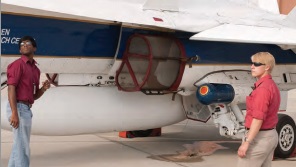Chapter: Engineering Successes, new invention technology, Research project papers,
Masking the Sun and Scoping the Problem

Masking the Sun and Scoping the Problem
Innovative hardware
upgrades to Armstrong's Airborne Schlieren Imaging System (ASIS) are improving
reliability and precision. The ASIS platform captures shockwave images by
aligning a supersonic aircraft between a camera-equipped aircraft and the sun,
and then watching as the shocks put an apparent ripple
on the sun's edge. The
technique enables researchers to validate data from supersonic models and wind
tunnel tests. Armstrong engineers recently designed and implemented adjustments
to the ASIS Forward-Looking Infrared (FLIR) camera pod to improve its performance.
Work to date: Innovators developed highly precise solar
masks that block all but the very edge of the sun. Since the
apparent solar radius changes throughout the year due to Earth's changing
proximity to the sun, the team created two masks that are 0.001 inches
different in radius-one for a summer mean radius and another for a winter mean.
A programmable tooling machine made manufacturing the masks straightforward;
the harder challenge was inspecting them. The
team employed a laser
projection device to create well-defined and accurately enlarged mask images,
enabling small radial measurements. The group also used borescopes to view a
'blind' connector that did not fully mate during pod assembly, causing routine
flight vibrations to induce intermittent system failures. A new connector
scheme allows for a more robust and fully mated connection.
Looking ahead: The team will continue to test and mature the
technology and to identify potential research partners.
' Armstrong has the tools, ingenu-ity, and skills on hand to
tackle difficult problems. The ASIS team made full use of these skills when
developing and improving the system. We look forward to
obtaining elusive
aircraft shock visuals with this equipment. '
Paul Bean, PI
Engineering Successes
Armstrong's Research and Engineering Directorate is responsible
for the overall engineering content of flight research projects. Our engineers
provide technical expertise in aerodynamics; guidance, navigation, and control;
propulsion; static and dynamic structures; flight hardware and software; flight
and ground test instrumentation and data systems; and system engineering and
integration. They apply their expertise across the spectrum of Armstrong's many
activities and also support the development and continual evolution of
engineering tools and test techniques. Here are highlights from a few recent
and particularly notable engineering success stories.
Related Topics